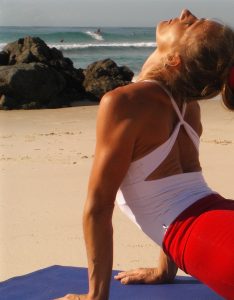“In experiencing breath and body simultaneously in complete awareness, the mind moves towards the ‘real Self’
(Atman).

At this juncture a state of equanimity of the mind, the intellect and the self (Samahita Citta) is achieved.”
(B.K.S. Iyengar)
The diaphragm, as the primary muscle of respiration, requires that the ribcage, which it attaches to is in its naturally aligned position. The diaphragm needs to contract and relax naturally with each breath.
Diaphragm and easeful breathing are directly related.
When breathing from the support of an aligned skeleton, the breath rises and falls from deep within, softly filling the back and the sides of the torso as well as the front. Try the following three exercises to see how misalignment restricts diaphragmatic movement and thus cause difficulty to breathe.
3 exercises for a more easy breath

Step 1
- Sit down. Let your self completely collapse into a slouched heap. Notice that your pelvis is tucked under (sad dog position) and your back is rounded and collapsed. Feel your ribcage sinking into your abdomen.
- Chances are your chin is out in front of you and the back of your neck is compressed. This is what it feels like for millions of people.
- Draw in three deep, slow breaths and notice what this feels like.
Are you able to sense the movement of your diaphragm? Where in your torso do you feel your breath?
Step 2
- Lift your chest as high as you can, pull your shoulders way back. Do you notice your back arching? Where else do you notice tension? Do you notice your neck tensing up?
- Now draw in three slow, deep breaths and notice how this feels.
- Are you able to sense the movement of your diaphragm, wherein your torso do you feel your breath?
Step 3
- Now locate your sit bone and press them gently into your seat. Ground your feet. On the next exhalation relax your chest downwards and feel your back growing wide. Drop your chin slightly so that the back of the neck is long.
- Now draw in three slow, deep breaths and notice how this feels.
- Are you able to sense the movement of your diaphragm, wherein your torso do you feel your breath?
Do you feel the breath filling the torso differently than in step 1 and 2?
Your body and stress

Skeletal alignment plays a significant role in certain respiratory disorders. The diaphragmatic muscle fibers must be in their natural configuration. Collapsing the chest or artificially lifting it upward are unnatural conditions that distort the fibers of the diaphragm and disrupt its ability to gently rise and fall with each relaxed breath. In extreme cases, distortion of the diaphragm and thoracic cavity can contribute to such stress-related disorders as chronic hyperventilation syndrome, anxiety, and panic attacks.
It is not uncommon for stress conditions to mimic symptoms of chest pain and heart attack that sometimes clear up quickly when natural, relaxed breathing is restored. Stress is one of the prime causes of premature illness and death. Stress triggers sympathetic nervous system dominance that interferes with the immune systems ability to ward off infections and diseases.
Deep natural breathing

Deep natural breathing, on the other hand, strengthens the parasympathetic nervous system, which encourages the immune system to work.
From a purely scientific point of view, skeletal alignment is not yet recognized as playing a significant role in promoting stress, but this is about to change since there is presently more research being done than ever on the effects of posture and body alignment determining the healthy functioning of all body systems and therefore overall health.
